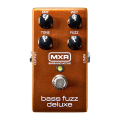The following is a guest review by Chad Beeler of BassEFX.com . If you are interested in guest posting, please contact me!
 “When pigs fly!â€Â It’s a snarky comment used when there’s belief that something will never happen. In the world of David Koltai, President of Pigtronix, pigs not only fly, they have jet packs launching them into deep space.  Motivated by the passion to build modern analog effect pedals in a digital age, Koltai, longtime friend and Pigtronix CEO Brian Bethke, and legendary electronics guru Howard Davis have made “Futuristic Analog Technology,†(aka F.A.T.) their mantra. Creating completely unique pedals that mash up different effects without borrowing or emulating other designs, Pigtronix has become one of the fastest growing pedal manufacturers.
“When pigs fly!â€Â It’s a snarky comment used when there’s belief that something will never happen. In the world of David Koltai, President of Pigtronix, pigs not only fly, they have jet packs launching them into deep space.  Motivated by the passion to build modern analog effect pedals in a digital age, Koltai, longtime friend and Pigtronix CEO Brian Bethke, and legendary electronics guru Howard Davis have made “Futuristic Analog Technology,†(aka F.A.T.) their mantra. Creating completely unique pedals that mash up different effects without borrowing or emulating other designs, Pigtronix has become one of the fastest growing pedal manufacturers.
The incubation of Pigtronix started at Middlebury College in Vermont, where Koltai and Bethke were students. Koltai was working toward a BA in music when a mutual friend, a physicist nicknamed “Pigpen†built a couple of pedals featured in Craig Anderton’s classic ‘70s DIY book called “Electronic Projects for Musiciansâ€. One was a basic optical compressor.  The other one, however, combined an envelope follower with a rotary phase shifter. Koltai totally dug it and asked Pigpen to built him another one with some additional switching features. That one didn’t work quite right, so Koltai decided to tear it apart and tackle the problem himself.  Grabbing the Anderton book, he sought to make the pedal even better. He did. And thus the first “Pigtron†was born. Spark causing the resultant fire, Koltai was stoked to keep learning, developing, and creating unique effect pedals. The first Pigtron became the Envelope Phaser 1 (EP-1) and it was time to see if there was a market. Where to look? NAMM Show!
Koltai and Bethke had to sneak the EP-1 into the 2003 Summer NAMM Show in Nashville in order to get some feedback from industry types and other builders. I’ve been to around a dozen NAMM shows and I can tell you that sneaking anything in is a difficult task. Destiny was sealed when the pair got to meet Bob Moog and Electro-Harmonix creator Mike Matthews. Koltai and Bethke came away from the show with the necessary feedback and a clear vision. Pigtronix was born. The EP-1 was put into production, which started in China for cost reasons, but Koltai ended up taking apart all the imported pedals just to make sure the quality control was solid. This massive time suck led the company to cease Chinese production and start building at home in New York; first, in a small apartment, then a slightly larger apartment, and so on until they could secure a warehouse for design, production, and distribution on Long Island, New York.
Wanting to push the creative design envelope, Koltai was in search of a guru to work with. It was suggested that he get in touch with Howard Davis, former head of Electro-Harmonix in the ’70s and creator of the Electric Mistress, Deluxe Memory Man, Poly Chorus, and other legendary offerings. Turns out that Davis lived somewhat nearby. The two met, talked, hit it off, and ultimately teamed up in 2005. An explosion of designs came to life: Disnortion, EP-2, (the latest update the Envelope Phaser) Tremvelope, Keymaster, Echolution, Mothership Guitar Synth, Philosopher’s Tone, Philosopher King and others. This rapid and successful industry climb has led to the creation of three Pigtronix pedals exclusively for bass players: Bass Fat Drive, Philosopher Bass Compressor, and the Bass Envelope Phaser. In a nod to the pedal that started it all the Bass Envelope Phaser has the fat and unique qualities of the EP-2, (which I should point out is already used by bass players,) but with a simplified feature set that makes it easier to dial in the effect. When I was informed that Pigtronix was working on bass specific pedals, I said “Sign me up!â€Â I didn’t have to hear them to know they would sound great and have that ultra cool Pigtronix graphic design. The Bass Envelope Phaser is of particular interest to me as I’m a huge fan of all envelope filters and their individual qualities and features. Plus, as a bass player, it’s just a super cool effect that immediately moves one to that scrunched up “funk faceâ€.
The Bass Envelope Phaser has a basic layout: “SENSITIVITY†and “RESONANCE†knobs and an “UP†OR “DOWN†sweep switch. The BEP runs off an 18v power supply, which is included, so there is a bunch of headroom, but it’ll behave differently with active and passive basses, so you’ll need to take note if you’re switching instruments mid-set. The “SENSITIVITY†knob allows for quickly pin pointing the sweet spot based on your attack, however, you’ll need to dial it differently depending on “UP†or “DOWN†usage. As a dedicated envelope filter it sounds great, getting help from the “staccato†envelope circuit which auto closes the filter between notes for extra clarity.  What really kicks it into gear and makes it totally unique is dialing up the “RESONANCE†knob, which introduces the almost humanizing effect of the phaser section of the pedal. It’s here that the BEP makes its mark and allows for the broadest range of sounds and sets itself apart from other envelope filters. Like all other Pigtronix pedals, the BEP has parallel processing of features, so the various effects are stacked on top of each other. Additionally, the clean signal is blended with the effected signal to maintain clarity instead of using a high pass filter, resulting in low end loss. So as soon as you kick it on, the BEP gives you the sound of your bass with the effect, without robbing the fundamental punch.
Like all other effects, there are many envelope filters on the market. Most of you probably already have one on your board. If you don’t, the Pigtronix Bass Envelope Phaser is a solid choice as a super fat envelope filter that can stand on its own. But here’s the thing: the Bass Envelope Phaser is unique enough in sound and performance that if you already have an envelope filter, you may want to add the BEP to your board anyway.
In a little less than a decade, Pigtronix pedals have been found in the hands of Victor Wooten, dUg Pinnick, Doug Wimbish, Tony Levin, Bakithi Kumalo, and Juan Aldrete among others. It’s a rapid rise based on design ingenuity, unwillingness to clone other pedals, and an unflinching belief in “Futuristic Analog Technologyâ€. Yep, at Pigtronix, pigs are not only flying, they’re going supersonic Blue Angels style.
About the author:
“I created BassEFX.com because the bass community clearly needed a place that would consolidate all the best effects pedals in one place. BassEFX.com gives bass players – and only bass players – a resource that showcases what’s available, offers the best advice and gets you the right effect. My background: I co-founded Bass Northwest, the world’s largest bass-only retail operation, and ran it for 15 years, (1994-2009.) In 30 years as a bass player, I’ve seen, heard, and played just about every amplifier, bass, cabinet and effect pedal imaginable.â€






Leave a Reply